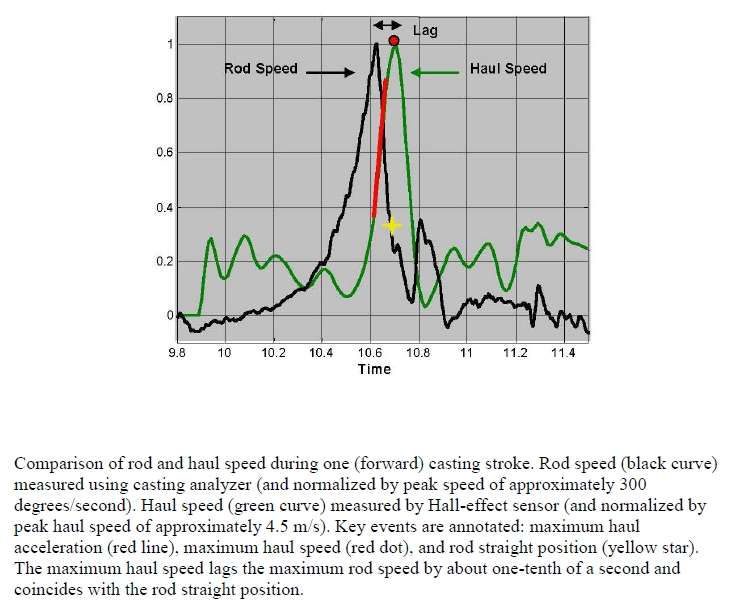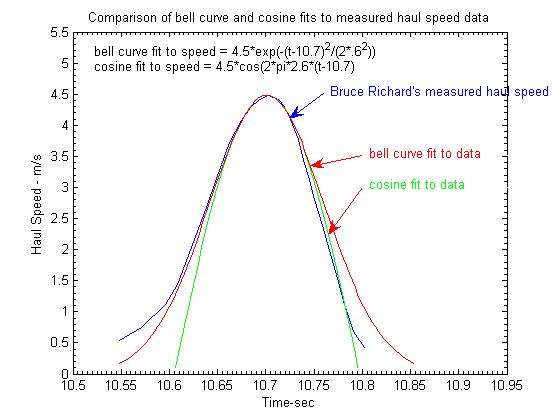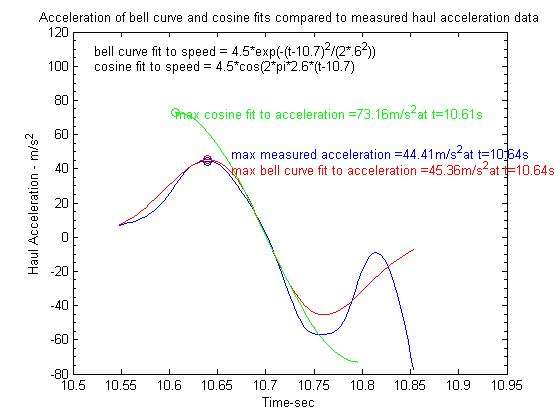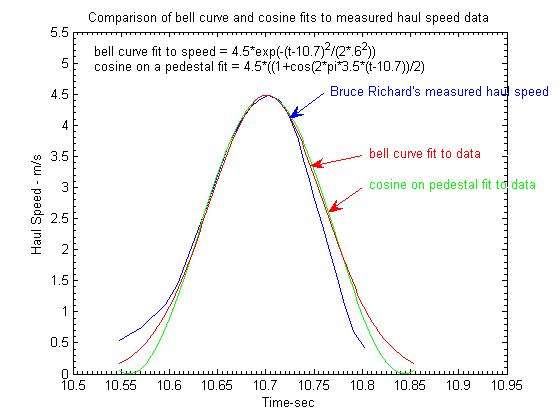PLEASE NOTE: In order to post on the Board you need to have registered. To register please email paul@sexyloops.com including your real name and username. Registration takes less than 24hrs, unless Paul is fishing deep in the jungle!
Hauling and the 170
Moderator: Torsten
Hauling and the 170
Hi all
Here is a few information after playing with the 2D casting model. The haul has two effects:
• Haul acceleration generates extra load for the rod; the corresponding gain in elastic energy stored by the rod is fed back into the line during rod unloading.
• Haul speed is directly added to the tip speed.
Maximum haul acceleration takes place at the beginning of the haul, before peak haul velocity (PHV). At maximum haul speed, the acceleration is nil. This peak velocity happens about halfway from the haul distance, with the exception of some asymmetrical hauls (double peak for example). The consequence of this difference in time (acceleration versus speed) is that these effects occur at different timings and you cannot get the best of both at the same time.
There can be different hauling styles. If we assume that we keep PHV constant and that we can tune haul timing nearly perfectly thanks to acquired experience, then let’s see the conditions maximizing one effect or the other.
• Best from extra load: it corresponds to a sharp quick haul on limited distance, with PHV just after MAV (e.g. 10 ms). In that case you get little from the direct haul speed effect.
• Best from haul speed: it corresponds to a lengthy haul over the largest possible distance, PHV taking place nearly halfway between MAV and RSP (e.g. 60 ms). In that case you get little from the extra loading of the rod.
The difference in performance is not that large. On the paper the first option gives a few % less line speed but a smaller loop. It seems then that there are numerous possibilities to perform a haul with an equivalent performance, provided it is properly tuned in time.
The biggest difficulty is to avoid a tail in the fly leg, and this can come from the extra loading effect only. However, even if you can smooth your haul the loading effect does exist anyway and may create a tail. That depends on the PHV intensity, and other (tackle) parameters, and the main mean to control that remains PHV timing: you have to delay your haul in time, starting the haul later. If you haul too late you are on the safe side for tails, but you lose some speed for the line. Not that bad after all, taking the very best of a haul is a problem for competitors, not fishermen.
The mechanical parameter which governs the "ideal" timing for the haul is (again) the loaded frequency of the rod: faster tackle (stiffer rod, less carry) means earlier hauls, slower tackle (softer rods, more carry) means later hauls.
Merlin
Here is a few information after playing with the 2D casting model. The haul has two effects:
• Haul acceleration generates extra load for the rod; the corresponding gain in elastic energy stored by the rod is fed back into the line during rod unloading.
• Haul speed is directly added to the tip speed.
Maximum haul acceleration takes place at the beginning of the haul, before peak haul velocity (PHV). At maximum haul speed, the acceleration is nil. This peak velocity happens about halfway from the haul distance, with the exception of some asymmetrical hauls (double peak for example). The consequence of this difference in time (acceleration versus speed) is that these effects occur at different timings and you cannot get the best of both at the same time.
There can be different hauling styles. If we assume that we keep PHV constant and that we can tune haul timing nearly perfectly thanks to acquired experience, then let’s see the conditions maximizing one effect or the other.
• Best from extra load: it corresponds to a sharp quick haul on limited distance, with PHV just after MAV (e.g. 10 ms). In that case you get little from the direct haul speed effect.
• Best from haul speed: it corresponds to a lengthy haul over the largest possible distance, PHV taking place nearly halfway between MAV and RSP (e.g. 60 ms). In that case you get little from the extra loading of the rod.
The difference in performance is not that large. On the paper the first option gives a few % less line speed but a smaller loop. It seems then that there are numerous possibilities to perform a haul with an equivalent performance, provided it is properly tuned in time.
The biggest difficulty is to avoid a tail in the fly leg, and this can come from the extra loading effect only. However, even if you can smooth your haul the loading effect does exist anyway and may create a tail. That depends on the PHV intensity, and other (tackle) parameters, and the main mean to control that remains PHV timing: you have to delay your haul in time, starting the haul later. If you haul too late you are on the safe side for tails, but you lose some speed for the line. Not that bad after all, taking the very best of a haul is a problem for competitors, not fishermen.
The mechanical parameter which governs the "ideal" timing for the haul is (again) the loaded frequency of the rod: faster tackle (stiffer rod, less carry) means earlier hauls, slower tackle (softer rods, more carry) means later hauls.
Merlin
Fly rods are like women, they won't play if they're maltreated
Charles Ritz, A Flyfisher's Life
Charles Ritz, A Flyfisher's Life
- Paul Arden
- Site Admin
- Posts: 19585
- Joined: Thu Jan 03, 2013 11:20 am
- Location: Belum Rainforest
- Contact:
Hauling and the 170
Hi Merlin,
Sorry, I've been meaning to reply. Is this a modelled haul or taken from a real cast? Why does maximum haul acceleration occur at the beginning of the haul? When you say that faster tackle means earlier hauls, do you mean earlier in time or earlier in the stroke?
Thanks,
Paul
Sorry, I've been meaning to reply. Is this a modelled haul or taken from a real cast? Why does maximum haul acceleration occur at the beginning of the haul? When you say that faster tackle means earlier hauls, do you mean earlier in time or earlier in the stroke?
Thanks,
Paul
Hauling and the 170
Hi Paul
This is a good point. For the time being I am using a model based on one of your haul records. It is a sine function, but I am preparing another model based on a bell shape function to test the difference. I hope to have something ready for tomorrow but let me give you a few basic information.
Let's assume the haul duration is 400 ms. For a sine model, it means that maximum acceleration occurs at 100 ms, maximum speed at 200 ms, maximum deceleration at 300 ms. For a bell shape model things are changing (I use simple figures here): maximum acceleration takes place at 150 ms, maximum speed at 200 ms and maximum deceleration at 250 ms.
On top of that the acceleration is 33% larger, that should impact the extra loading of the rod. At the same time acceleration and speed optimum being closer, that should be favorable.
I guess the consequences will be noticeable in terms of performance, we shall see. Anyway this will give us two cases on the borderline side (soft/hard) in terms of hauling.
Merlin
This is a good point. For the time being I am using a model based on one of your haul records. It is a sine function, but I am preparing another model based on a bell shape function to test the difference. I hope to have something ready for tomorrow but let me give you a few basic information.
Let's assume the haul duration is 400 ms. For a sine model, it means that maximum acceleration occurs at 100 ms, maximum speed at 200 ms, maximum deceleration at 300 ms. For a bell shape model things are changing (I use simple figures here): maximum acceleration takes place at 150 ms, maximum speed at 200 ms and maximum deceleration at 250 ms.
On top of that the acceleration is 33% larger, that should impact the extra loading of the rod. At the same time acceleration and speed optimum being closer, that should be favorable.
I guess the consequences will be noticeable in terms of performance, we shall see. Anyway this will give us two cases on the borderline side (soft/hard) in terms of hauling.
Merlin
Fly rods are like women, they won't play if they're maltreated
Charles Ritz, A Flyfisher's Life
Charles Ritz, A Flyfisher's Life
Hauling and the 170
Some illustrations (sorry for the typo)
You can see the difference, the bell shape haul is more dynamic.
Merlin
Merlin
Fly rods are like women, they won't play if they're maltreated
Charles Ritz, A Flyfisher's Life
Charles Ritz, A Flyfisher's Life
Hauling and the 170
The bell shape haul is so particular (exponential function for speed) that the duration has no significant effect, all looks like a compact haul and the best tuning is right on MAV for peak haul velocity. If you delay the haul to bring the peak haul speed closer to RSP, the performance is significantly reduced (e.g. 15% less line speed) although you get the haul speed bonus at the end.
I have no record of a bell shape haul, but I think I have something not so far from it, I shall look after.
Consequencies: it is likely that most hauls have a sine wave form, like Paul's one, and that it creates a window for placing the haul between MAV and RSP. Fine tuning a bell shape one right on MAV could be difficult, with no benefit by comparison to a short sine wave one. Longer sine wave hauls are more performing than longer bell shape ones.
A bit complicate, isn't it? It looks like hair splitting somewhere, but it means that we do not have to look after a brutal haul, just a speedy one.
Merlin
I have no record of a bell shape haul, but I think I have something not so far from it, I shall look after.
Consequencies: it is likely that most hauls have a sine wave form, like Paul's one, and that it creates a window for placing the haul between MAV and RSP. Fine tuning a bell shape one right on MAV could be difficult, with no benefit by comparison to a short sine wave one. Longer sine wave hauls are more performing than longer bell shape ones.
A bit complicate, isn't it? It looks like hair splitting somewhere, but it means that we do not have to look after a brutal haul, just a speedy one.
Merlin
Fly rods are like women, they won't play if they're maltreated
Charles Ritz, A Flyfisher's Life
Charles Ritz, A Flyfisher's Life
- Paul Arden
- Site Admin
- Posts: 19585
- Joined: Thu Jan 03, 2013 11:20 am
- Location: Belum Rainforest
- Contact:
Hauling and the 170
It's funny it's not how it feels, especially on the backcast. It would be great if we could invent a machine to measure the haul. It would be good for training too.
Is there an easy way to do this?
Cheers, Paul
Is there an easy way to do this?
Cheers, Paul
- gordonjudd
- Posts: 1858
- Joined: Sat Jan 19, 2013 11:36 pm
- Location: Southern California
Hauling and the 170
Paul,It would be great if we could invent a machine to measure the haul.
and
Is there an easy way to do this?
Probably not so easy, but Ben Meyers, Noel Perkins, and Bruce Richards used a line with painted ferro-magnetic strips and a Hall effect sensor to measure Bruce's haul speed timing on a non-distance cast.
On that cast the max haul speed of around 4.5 m/s was reached a bit after RSP1.

Gordy
- gordonjudd
- Posts: 1858
- Joined: Sat Jan 19, 2013 11:36 pm
- Location: Southern California
Hauling and the 170
Merlin,I have no record of a bell shape haul,
Just eyeballing the haul speed curve that Noel Perkins measured for Bruce Richards' haul on a shorter cast shown above it appeared to me that it had a bell curve shape.
I tried fitting a bell curve to that data where the goal was to match the upper half of the measured curve and not the start and stop times as you showed in post 24 above. I also did the same type of fit using a cosine function that had a much smaller zero crossing width, but was a close match to the upper part of the measured curve.
Here is a plot of the measured velocity values (blue), the bell shaped curve (red) and the narrower cosine fit (green) to the main lobe of the measured velocity values.

You can see both the bell shaped and cosine fits matched the upper part of the measured data quite closely (although the closeness of the fit might be in the eye of the person varying the fitting parameters).
If you look at the tail regions you can see the bell shaped fit matched the forward part of the haul quite well, while the faster roll off of the measured data was matched more closely with the cosine fit.
Those fitting differences are more apparent when you look at the acceleration curves. Here it appears the bell shaped curve gives a better match to the measured acceleration curve as shown below.

Thus based on the measured haul speed shape of Bruce's haul, I don't think it would make much difference if you used a bell shaped curve or a cosine function to plug into your model, as long as you were trying to match the main lobe of the measured data.
Gordy
Hauling and the 170
Hi Gordy
My intention was to compare two situations with different peak acceleration / peak speed timings, not to match a record. For matching I use a sine function (e.g. Paul's haul).
My cosine function is slightly different from yours, in Bruce's example it would be something like:
4.5*[1+cosine(2pi*3.3*(t-10.7)]/2
The match for acceleration should be better.
I am going to look after the effect of overall tackle frequency. We have two effects, the side one occuring earlier and corresponding to a delay in rod response (which is quite short with modern tackle). If I take a soft rod I should be able to get sufficient delay for rod response and be able to move it close to the peak speed moment. Then I may be able to get the best of the direct and indirect haul effects at the same time. It could be a noodle
Merlin
My intention was to compare two situations with different peak acceleration / peak speed timings, not to match a record. For matching I use a sine function (e.g. Paul's haul).
My cosine function is slightly different from yours, in Bruce's example it would be something like:
4.5*[1+cosine(2pi*3.3*(t-10.7)]/2
The match for acceleration should be better.
I am going to look after the effect of overall tackle frequency. We have two effects, the side one occuring earlier and corresponding to a delay in rod response (which is quite short with modern tackle). If I take a soft rod I should be able to get sufficient delay for rod response and be able to move it close to the peak speed moment. Then I may be able to get the best of the direct and indirect haul effects at the same time. It could be a noodle
Merlin
Fly rods are like women, they won't play if they're maltreated
Charles Ritz, A Flyfisher's Life
Charles Ritz, A Flyfisher's Life
- gordonjudd
- Posts: 1858
- Joined: Sat Jan 19, 2013 11:36 pm
- Location: Southern California
Hauling and the 170
Merlin,For matching I use a sine function (e.g. Paul's haul).
and
My cosine function is slightly different from yours
Is your sine function also on a pedestal so in effect it becomes a sine squared function?
As you pointed out the cosine on a pedestal type fit gives a better fit to the measured acceleration function, but then it also becomes almost identical to the bell curve fit as shown below.

Since the raised cosine function fit is almost the same as a bell shaped fit (if you use the proper choice of fitting parameters) would it make any difference which type of function you used?My intention was to compare two situations with different peak acceleration / peak speed timings,
Couldn't you just use one or the other type of function and get the same effect by changing the sigma for the bell shaped curve or the frequency for the raised cosine fit to illustrate the effect that timing and the duration of the haul would have on the ultimate line speed?
At least for the raised cosine type of fit (and I agree that is a better match to actual measured data) isn't the use of a raised cosine fit or a bell shaped curve a distinction that has no real difference aside from the duration and magnitude of the tails they produce?
Gordy
